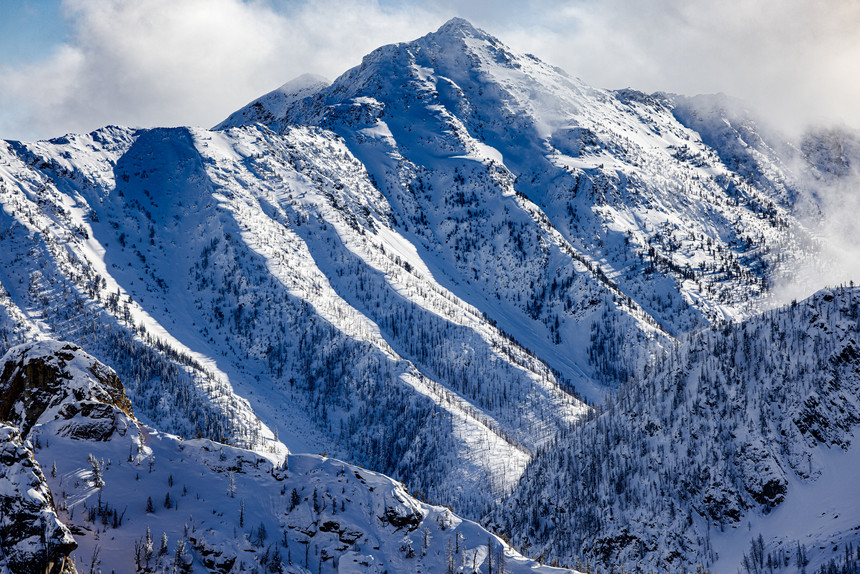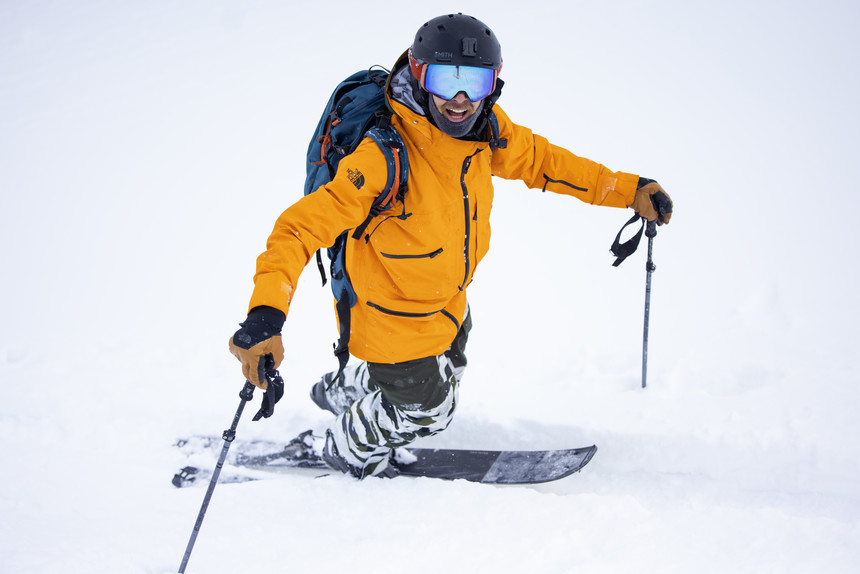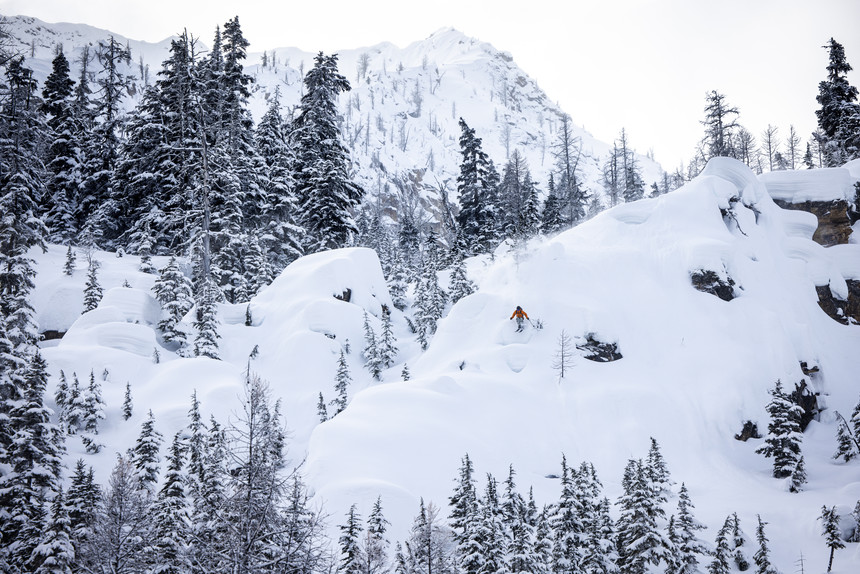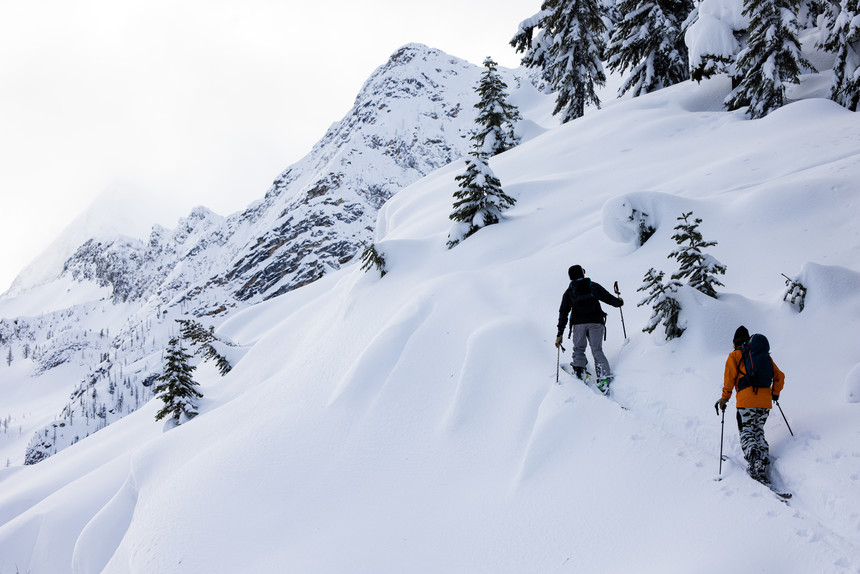 While it might look easy for Sage to shred a line like this, there's a whole lot of planning and patience that goes into it. | Eric Parker photo.
While it might look easy for Sage to shred a line like this, there's a whole lot of planning and patience that goes into it. | Eric Parker photo.
Sage Cattabriga-Alosa has almost certainly spent more hours in the backcountry than you have. As a member of the TGR team for over 20 years now, he’s developed a keen sense for staying out of trouble in the mountains. The Atomic athlete urges patience, learning, and practice for anyone going out of bounds this season and has a few tidbits of wisdom to share with us about moving through the mountains. Whether you are ski touring, snowmobiling, or just bumping out the gates to access your favorite stash, Sage has something for you.
Identifying Avalanche Terrain:
The first step to staying safe in the mountains is to be able to identify hazards like avalanche terrain. You can only manage your risks if you properly understand them. While skiing and riding steep and deep terrain might sound enticing, knowing what avalanche terrain looks like so you can avoid it is the easiest way to avoid being buried. Sage says, "In reality, most things we like to ski are avalanche terrain, so I treat treat everything as avalanche terrain until proven otherwise." In a nutshell, any terrain that is over 30 degrees in steepness has the potential to create an avalanche.
 Can you identify potential avalanche paths on this mountain? | Eric Parker photo.
Can you identify potential avalanche paths on this mountain? | Eric Parker photo.
This terrain can carry elevated consequence depending on what’s below it, whether it’s a terrain trap like a gully or a big cliff. Don’t forget that avalanche terrain also includes lower angled slopes that are directly underneath steeper slopes that can slide, like the seemingly mellow apron of a couloir or traverses underneath cliffy terrain. Also, Sage urges us to not forget about other common hazards like tree wells, cornices, pillow collapses or buried rocks.
Making a Tour Plan:
Before heading out on a day skiing in the backcountry, Sage always makes a plan. He gathers as much information as possible about the terrain, avalanche conditions, and weather from sources like his local avalanche center, maps, and his own experience in zones he frequents. “I don’t go out with as much of a goal as I do a plan," Sage says, "I go out, gather info, assess what’s actually going on with avalanche risk and then mitigate accordingly.”
He reminds us that avalanches can happen while you are skinning up, so make sure your ascent path stays out of avalanche terrain whenever possible. You’re always better off going a little further to avoid a questionable feature than risking getting caught in a slide. Sage will use tools like mapping software to identify slope angles and measure distances to plan his route and make a plan B or C. "I use past observations from myself or folks in my party, information found online, and then field observations to form a bigger picture of what’s going on in the mountains," he says. Finally, he will communicate with his partners to make sure everyone is one the same page and stoked about the plan!
 Checking out conditions along the skintrack. | Eric Parker photo.
Checking out conditions along the skintrack. | Eric Parker photo.
Sage points out that he likes to look at terrain on a macro scale first, identifying obvious hazards like terrain traps, open steep faces, and places where a slope rolls over abruptly. Those are spots he will keep an extra eye on and avoid if there’s any concern about a slide, especially on the ascent. Next up, he looks for ridges, lower angle slopes, and tighter trees that can provide safe passage to the top. If Sage is looking at a specific line to ride, he will identify safe zones for himself and partners to stop out of the path of moving snow. These include standing on ridges or outcroppings, stopping far enough away from the bottom of a runout or tucking into tree islands that can provide some cover.
Adapting The Plan:
Just because you made a plan beforehand, doesn’t mean it can’t change. Once he’s out in the field, Sage constantly makes observations about the snow and weather. If he notices any of the Five Red Flags (rapid warming, high winds, recent avalanche activity, cracking or whumpfing, or lots of new snow), he will assess and potentially adapt the plan to build in a bigger safety margin. "Going out with flexibility as your main objective is a really good way to mitigate risks," Sage says. Secondly, if there’s any evidence of a weak layer and a slab in the snowpack (either from the avalanche report or from a snow pit he digs in the field) he will stay away from avalanche terrain completely and keep the skiing to low-angled slopes. That’s why having a safer plan B or plan C that you are stoked about is key to a successful day in the mountains.
"My method of going out is always being in a fluid state. I take it all in, whether it's temps, sounds, visual cues, or whatever it is that I’m picking up. In the big picture, I’m out here to have a good experience, and the good skiing will come. There’s always another day to ski if it doesn’t work out today!” he says.
 When Sage drops into a line, he's confident that it will work, or else he heads elsewhere. | Eric Parker photo.
When Sage drops into a line, he's confident that it will work, or else he heads elsewhere. | Eric Parker photo.
Riding The Line:
Once you’ve made it to the top of your line, you’ve done most of the hard work. But don’t turn your brain off. This is where the riskiest part begins. Before dropping into a line, no matter if it’s a mellow tree run or a big-mountain line for the camera, Sage always thinks about where hazards could lie on the descent. "This is where it really starts to depend. I call this the ‘who, what, where, when, how’ method," he says, "To me the risk, and the hazards change depending on all those variables." That means he will adapt his approach to an objective, or the objective itself based on who he is with, what the objective is, where the group is, what time of day (or season) it is, and how they plan to ski it.
 When everything else seems too dangerous, soul laps in the trees are always a great plan B. | Eric Parker photo.
When everything else seems too dangerous, soul laps in the trees are always a great plan B. | Eric Parker photo.
He never drops into something he's not confident about on a given day. "When I’m on top of a line and ready to ski it, I’m pretty confident in how I’m getting down, and the stability of the snow. If I’m not, then I should go do something different," he says. Even if the danger rating is low and conditions are perfectly stable, he still thinks about skiing a line in a way that gives him exit options if something does prove unstable.
"Know your safe zones and adapt them to your group’s ability. If there any extra risks present based on skill level, I’ll often downsize the terrain by finding more stopping points or avoiding certain features. That gives us more options for visibility and upping the safety margin," Sage says.
 If it's good, go up again!. | Eric Parker photo.
If it's good, go up again!. | Eric Parker photo.
Know Your Exit:
Finally, after skiing a line, Sage reminds us that we still must get home. Assuming you are returning the way you came in, you should already be familiar with any hazards you encountered on the approach. That being said, conditions can change throughout the day, your group will be tired, and especially in the springtime, slopes can heat up and cause dangerous wet slides later in the day. Part of his pre-trip planning process also includes making a strategy for his exit. Particularly in the spring, if conditions change throughout the day, consider taking a different route out that avoids solar aspects or traversing underneath cliffs than can shed snow. That way, you'll all be back at the parking lot before dark and can enjoy reminiscing the day over a few cold beers!



vinnu
January 10th, 2022
WONDERFUL ARTICLE AND I REALLY LOVED IT BY Yacine TV
Angela224
January 14th, 2022
This is a really interesting post. I love it!!
Chelmsford Kitchen Fitters
James Smyth
January 17th, 2022
This is an awesome and coherent post! A true inspiration for our tree trimming team!
Angela224
February 1st, 2022
best series
Angela224
February 1st, 2022
Thanks for sharing this informative post. I really admire your work.
Our website
fshfurniture
September 7th, 2022
Shop Online Sectional sofa Dubai, L Shape ,U Shape in Dubai, ... And Luxury Designed Sectional Sofa AT Fsh furniture
tetowig
September 7th, 2022
apart from this you can play online games on https://jojoy.vip/